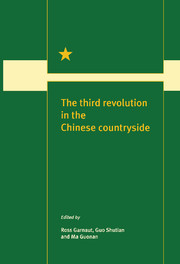Book contents
- Frontmatter
- Contents
- Figures
- Maps
- Tables
- Contributors
- Preface
- 1 The third revolution
- Feeding the people
- Marketing and price reform
- Internationalisation
- 12 The World Trade Organization and agricultural development
- 13 Comparative advantage and the internationalisation of China's agriculture
- 14 A turning point in China's agricultural development
- Regional issues
- Institutional change
- References
- Index
12 - The World Trade Organization and agricultural development
from Internationalisation
Published online by Cambridge University Press: 04 August 2010
- Frontmatter
- Contents
- Figures
- Maps
- Tables
- Contributors
- Preface
- 1 The third revolution
- Feeding the people
- Marketing and price reform
- Internationalisation
- 12 The World Trade Organization and agricultural development
- 13 Comparative advantage and the internationalisation of China's agriculture
- 14 A turning point in China's agricultural development
- Regional issues
- Institutional change
- References
- Index
Summary
China was a founding member of the General Agreement on Tariffs and Trade (GATT) but its membership has been suspended for more than forty years. The Chinese government began discussions in 1986 with contracting parties to the GATT to regain its membership and, if successful, to enjoy the rights of a founding member. The formation of a new World Trade Organization from 1 January 1995, as a successor to the GATT, has heightened China's sense of urgency to regain membership. It will then be obliged to assume corresponding commitments that will have implications for Chinese agriculture.
Direct and indirect benefits from WTO membership
After regaining membership of the WTO, China will enjoy more secure access to international markets, tariff reduction by trading partners and an easing of non-tariff barriers. Importantly, acceptance as a developing country member would enable China to enjoy preferential treatment in its trade with industrial countries, including more time to liberalise imports from them, and preferential tariffs on exports to them. These preferences would stimulate the expansion of cooperation in agricultural production between China and the rest of the world. In addition, the implementation of the Uruguay Round will see freer trade in agricultural products and enhance the power of the WTO to maintain open international trade. This will provide a better climate for agricultural trade in the world market.
- Type
- Chapter
- Information
- The Third Revolution in the Chinese Countryside , pp. 166 - 171Publisher: Cambridge University PressPrint publication year: 1996



